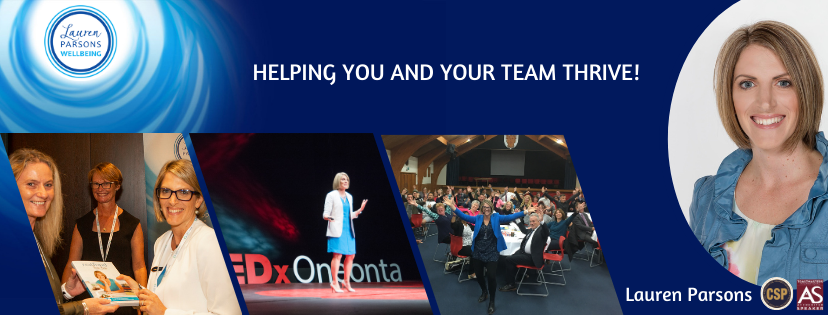An excerpt from Lauren Parsons’ book ‘Thriving Leaders Thriving Teams’.
Being able to talk about stress and how you’re feeling at work is an important part of managing mental distress. Not being about to talk about it exacerbates the problem.
As a leader it’s important to be able to listen to your staff when they’re going through difficult periods. You need to be able to spot the signs of mental distress and know how to respond. The US National Council for Mental Wellbeing developed the ALGEE process, outlining a step-by-step approach to respond to someone in mental distress.
A = Ask, assess and assist in a crisis.
L = Listen non-judgmentally.
G = Give reassurance and information.
E = Encourage appropriate professional help.
E = Encourage self-help and other support strategies.
Using the ALGEE approach can give you confidence to ask how someone is really doing. Remember you don’t need to solve their problems. All that’s required is to listen non-judgmentally, give reassurance and encourage them to get support. This makes it easier to take that first step and ask.

Do’s and Don’ts
Here are some of the ‘dos’ and ‘don’ts’ to build trust and create opportunities for meaningful conversations:
DO
- Choose a good time and place to connect.
- Have conversations in an appropriate, private setting where they can feel most comfortable. If you don’t have an appropriate space on-site, head outdoors for a walk or connect at a café.
- Let people know your conversation will remain confidential.
- Listen actively without judgement.
- Slow down and take your time.
- Talk about mental health and mental fitness in a positive way.
- Follow through if you promise to do something (like check in again).
DON’T
- Bring up private or sensitive conversations in a public space.
- Try to jump straight in to solve problems (listen first and ask open questions).
- Tell them they should ‘just relax’ or ‘toughen up’.
- Tell people what they have to do or what you’d do if you were them (everyone is unique in how they’ll respond).
- Involve other people without discussing it with the individual first.
(Note that if you’re concerned that they or someone else may be at risk of physical harm this is an instance where you can legitimately break confidences and get help from others. Don’t try to keep things secret or manage the situation on your own.)

Starting the Conversation
Open with an “I’ve noticed…” statement to start the conversation, then listen.
Helpful conversation starters:
- I’ve noticed you seem quieter than normal, how are things going at the moment?
- I’ve not seen you in the staff room this month. Is everything ok?
- I’ve noticed you haven’t put your camera on in our meetings lately. I just wanted to check in to ask how you are.
- I’m here to listen if you need it.
- What went well this week? / What didn’t go so well?
- How are you finding your workload right now?
- How are things going at home?
One of the most important things when starting the conversation is your tone of voice (along with picking a suitable time and location). Show empathy and genuine concern through your tone and body language.
Enjoyed this article?
To find out more about having tough work-related conversations, read the whole Thriving Leaders, Thriving Teams book. Order your copy today here.
Complete will full colour, full page illustrations, it’s a fantastic guide to help you stop languishing and start flourishing.
“WOW – just WOW. A brilliant book which skilfully pulls together current thought leadership into a cohesive whole enabling real planning and action.”
– Linda Norris, Operations Manager, Pinnacle Midlands Health.
“A must read for all leaders to support the wellbeing of their teams. Thriving Leaders, Thriving Teams breaks down these big topics into bite-size chunks which you can easily act on. Filled with fantastic personal and professional stories, and actionable points. I’ll be referring to my post-it-covered copy often!”
– Kerri Bainbridge, HR Consultant.
About the Author – Lauren Parsons, CSP, AS
Lauren is a keynote speaker, author and consultant who’s passionate about helping busy people discover little-used techniques to boost their energy, vitality and performance. She’s the only speaker in the world to focus on lifting BOTH workplace wellbeing and productivity.
Awarded NZ Keynote Speaker of the Year and Educator of the Year 2023/24 by the Professional Speakers Association. Lauren is a sought-after international speaker, one of only a dozen Certified Speaking Professionals and the only Accredited Speaker in New Zealand.
TEDx speaker, Author of Thriving Leaders Thriving Teams and Real Food Less Fuss, Founder of the Snack on Exercise movement and host of the Thrive TV Show. With over 20 years’ experience, Lauren integrates her wellness and business background to help leaders find the sweet spot between boosting both wellbeing and productivity.
Described as unforgettable and life-changing, Lauren is a dynamic and highly-engaging presenter, and master story-teller who will have you laughing, moving and learning in a memorable way. Whether it’s virtual or in-person, you will leave Lauren’s session feeling uplifted and empowered to create positive change, today!
Based in the Manawatu, New Zealand, where she lives with her husband and three children, Lauren can often be found hosting dinner parties, playing board games, running, reading or getting out in her gumboots to walk the paddocks. She travels regularly to speak at conferences and in-house and specialises in helping leaders create positive, energised workplaces where people thrive.
Check out all the goodness at Lauren’s “Free Stuff” page at www.LaurenParsonsWellbeing.com

Ways to connect with Lauren
- Find out about conference keynotes
- See her most popular topics
- Make a time for a virtual cuppa over zoom
Share this Post
